Gray Whale Facts
- Order: Cetacea
- Suborder: Mysticete (Baleen)
- Family: Eschrichtiidae
- Species: Eschrichtius robustus
- Status: Lower risk
- Weight: 14-35 tons
- Southbound: mid-November to mid-February (January peak)
- Northbound: mid-February to mid-May (mid March peak)
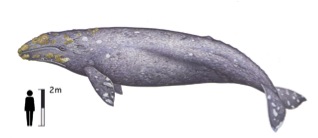
The most familiar of our whales is the gray whale. We are fortunate that they migrate close to the coast so we can often see them from shore and from short whale-watching trips on boats.
Size and Identification
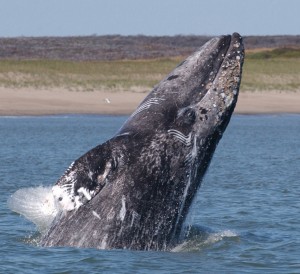
The gray whale is a medium-sized whale averaging about 45 feet and weighing around 35 tons; females are slightly larger than males. They are best identified by their robust shape, less streamlined than other whales, their mottled gray and white coloring enhanced by numerous barnacles and whale lice, and their lack of a dorsal fin. In place of the dorsal fin, gray whales have a series of “bumps” or “knuckles” just in front of the tail that are distinctive. The gray whale’s spout is straight up, short and bushy. The spout is usually visible for about 1 second or so before it dissipates. Gray Whales are occasionally seen “breaching”, aggressively leaping out of the water and returning with a big splash. They can also often be seen “spy-hopping,” sticking the tip of the rostrum out of the water slowly and then slowly sinking back underwater.
Barnacles
There is one species of barnacle and three species of whale lice that live on the gray whale. The barnacle (Cryptolepas rhachianecti) is unique to the gray whale, and of the three species of whale lice (in the genus Cyamus), two are found only on gray whales. Being mammals, gray whales also show scattered hairs around the region of their head.

Feeding

Gray whales are baleen whales that have a short, very coarse baleen relative to other whales. Their feeding habits are also unique, they actually “suck” mud from the bottom of ocean and filter out the many crustaceans and worms that live in the mud. Stirring up the bottom actually provides food for other animals as well, birds and fish follow feeding gray whales regularly.

Migration
Probably the most amazing thing about gray whales is their annual migration; gray whales undertake the longest annual migration of any known mammal. A large majority of gray whales spend the summer in the Bering and Chukchi Seas building up fat for their incredible journey. The whales leave their summer feeding grounds in early fall and migrate all the way to Mexico, a distance of close to 6,000 miles one way! Amazingly, they appear not to feed during the southerly migration so they lose almost a third of their body weight during the winter, especially females who are nursing a new calf. Recent observations suggest that the females will feed on the journey north after giving birth to a calf, and that males and females without calves will also do some feeding on the northerly trip, but the prime feeding for most of the whales are on the summering grounds.
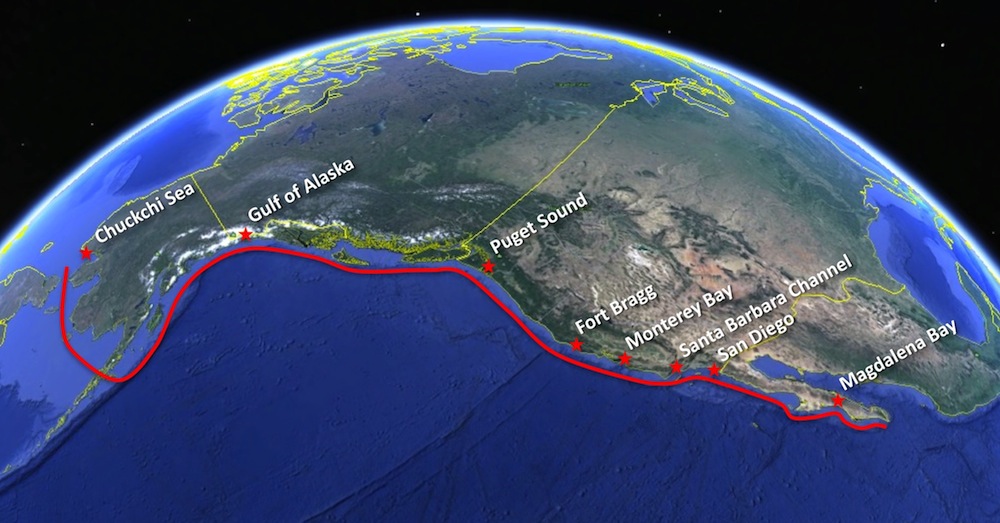
Click on the icons above to for more information about gray whales during their migration.
The migration occurs very close to shore, making the gray whale one of the easiest whales to observe from our coast. Gray whales begin to pass south past Fort Bragg in mid-December, with the pregnant females leading the way to the warm and calm waters of the lagoons in Baja California. The pregnant females are followed by the males and other females. Females generally give birth every other year, so about half of the females will be pregnant in a given year. Peak southerly migration takes place in early January. By mid-February, some of the whales are beginning to travel north. March is probably the best time to see the migrant whales, as they spend more time in this area and seem to be closer to shore, spending more time spy-hopping, breaching and hanging out in small groups.

Population Status
We estimate that there are now over 22,000 gray whales, a dramatic increase from the early part of the 1900’s when they were considered close to extinction. In the mid-1900’s they were protected from whaling and then added to the Endangered Species list in 1969. By 1994, their population was so recovered that they were one of the first species to be delisted. Estimates of pre-whaling populations are difficult [for what?] but may range from 36,000 to over 100,000 whales. Today’s population seems stable and may be slowly increasing.




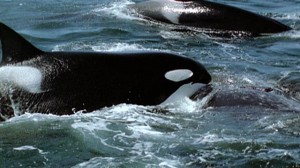 Orcas are the main natural predators for gray whales and the most dangerous part of their migration route is along the Monterey coast. Scores of killer whales patrol Monterey Bay, ambushing gray whales and picking off their young as they attempt to cross a deep water canyon. Most of the attacks occur along the edge of the drop off, where packs of between 4-7 mostly female orcas use the cover of deep water to approach from underneath. It has been estimated that up to 30% of gray whale mortality is due to orca predation.
Orcas are the main natural predators for gray whales and the most dangerous part of their migration route is along the Monterey coast. Scores of killer whales patrol Monterey Bay, ambushing gray whales and picking off their young as they attempt to cross a deep water canyon. Most of the attacks occur along the edge of the drop off, where packs of between 4-7 mostly female orcas use the cover of deep water to approach from underneath. It has been estimated that up to 30% of gray whale mortality is due to orca predation.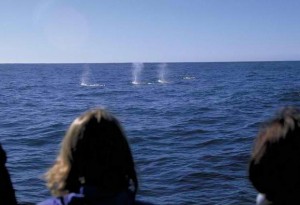 Gray whales are believed to use landmarks for navigation, and often will lift their heads out of the water and spin slowly to see better. This is called spy-hopping. When a whale leaps out of the sea it is called breaching. And of course there are the spouts. Great places to see whales along our coast are Spring Ranch, the Mendocino Headlands, Point Cabrillo Lighthouse, the Noyo Center, and MacKerricher State Park.
Gray whales are believed to use landmarks for navigation, and often will lift their heads out of the water and spin slowly to see better. This is called spy-hopping. When a whale leaps out of the sea it is called breaching. And of course there are the spouts. Great places to see whales along our coast are Spring Ranch, the Mendocino Headlands, Point Cabrillo Lighthouse, the Noyo Center, and MacKerricher State Park. Not every migrating gray makes the entire journey to Alaska. A subgroup of about 200 whales make up what is known as the Pacific Coast feeding group and feed instead in Washington's Puget Sound or Oregon's Depoe Bay. Researchers first began tracking these whale in the early 1990's and a few, like "Little Patch" (pictured here), a male gray that spends summers near Seattle, are local celebrities.
Not every migrating gray makes the entire journey to Alaska. A subgroup of about 200 whales make up what is known as the Pacific Coast feeding group and feed instead in Washington's Puget Sound or Oregon's Depoe Bay. Researchers first began tracking these whale in the early 1990's and a few, like "Little Patch" (pictured here), a male gray that spends summers near Seattle, are local celebrities. Gray whales eat very little along the migration route to and from Alaska and animals that don't eat enough over the summer may not survive the entire journey. When an adult whale leaves the feeding grounds, they weigh appoximately 30 tons, and by the time they return, they've lost about ⅓ of their weight.
Gray whales eat very little along the migration route to and from Alaska and animals that don't eat enough over the summer may not survive the entire journey. When an adult whale leaves the feeding grounds, they weigh appoximately 30 tons, and by the time they return, they've lost about ⅓ of their weight. Before heading out on their epic 7-8 month migration, gray whales feed in the cold, rich waters of the arctic. Dwindling daylight, cooling temperatures and depleted food supplies signal the time to begin the journey again. However, climate change may be warming water temperatures, resulting in delayed departures and possibly a reduction in the amphipod population gray whales depend upon.
Before heading out on their epic 7-8 month migration, gray whales feed in the cold, rich waters of the arctic. Dwindling daylight, cooling temperatures and depleted food supplies signal the time to begin the journey again. However, climate change may be warming water temperatures, resulting in delayed departures and possibly a reduction in the amphipod population gray whales depend upon.